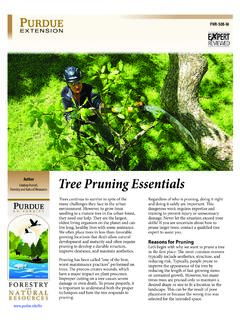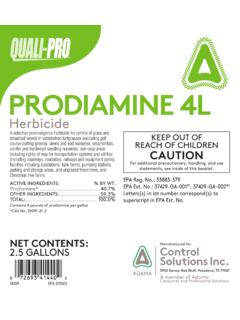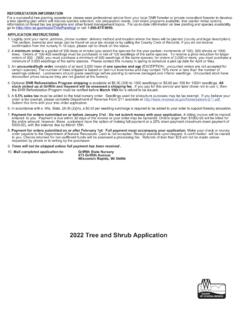Transcription of ORGANIC VEGETABLE PRODUCTION - Agricultural Training …
1 ORGANIC VEGETABLE . PRODUCTION . 1. Introduction The VEGETABLE industry is one of the major sources of livelihood for millions of Filipino farmers and businessmen. It is a good source of vitamins and minerals such as Vitamin A, B, C, Iron as well as protein and dietary fiber for the right nutrition or food for the body. Extensive cropping and long term application of chemical fertilizers, pesticides & other inputs in VEGETABLE plantation have resulted to soil degradation and nutrient depletion. With this condition, land area devoted to VEGETABLE PRODUCTION have poor soil quality with a characteristic of low soil ORGANIC matter, acidic and low levels of macro and micro nutrients. In response to these challenges, the Department of Agriculture under the ORGANIC Agriculture Program (OA) promotes the use of ORGANIC fertilizer that is fully decomposed at stable temperature with no foul smell.
2 Poverty and increase of population may cause hunger and lack of food. But if the people will be empowered to produce and consume vegetables it would solve the malnutrition problem in the countryside. 2. MANAGEMENT PRACTICES. I. Choosing the Appropriate Variety and Securing Good Quality Seeds Adaptability to climatic condition With potential yield Maturity (early & late maturing varieties). Resistance to insect pests & diseases High market demand Viability True-to-type seed Varieties of Vegetables a. Open Pollinated Variety (OPV). Improved seed material grown for a long period of time and maintained by natural cross pollination from generation to generation ( VEGETABLE pollen agents-insects/wind). Seeds from harvest could be used as seeds.
3 B. Hybrid Seeds A good synthetic variety that could be developed by combining a good inbred lines from one or more varieties and allowing at least one or more varieties & allowing at least one generation for stabilization. The seeds from harvest cannot be used as seeds because there is tremendous reduction of yield due to inbreeding. II. Site Selection for Raising Seedlings Sufficient source of water/availability of irrigation water. Free from water logging and well drained soil/field. Away from trees/structures to avoid shading. Presence of wind breakers (buffer-zone). Far from street/artificial lights. Free from pests & diseases. Free from contamination (physical, chemical, biological). 3. III. Raising of Seedlings A. Seed Box Method 1.
4 Make seed boxes (1m x 1m x 15cm) or any desired size and put holes at the bottom for drainage. 2. Mix the potting media thoroughly. - 1 part river sand - 1 part garden/top soil - 1 part compost/vermi-compost - 1 part coconut coir dust - 1 part carbonized rice hull, etc. 3. Sterilize the soil medium with hot water using sprinkler. 4. Put the soil/potting media in the seed box. 5. Place seed box on perforated bench or high slatted structures to be elevated and easy to be drained when irrigated. Characteristics of a Good Soil as Medium Characteristics of a Good Sand as Medium 1. Sieved sand (use fine screen). Friable ( naruka ). Free from soil-borne pests and diseases (biological/microbial). Rich in macro and micro-nutrients Fertile, porous, etc.
5 Free from contamination (physical and chemical). 4. 2. Free from pests and diseases 3. Free from contamination 4. Fine, pure, etc. 5. High water holding capacity Characteristics of a Good Compost as Medium 1. Fully decomposed (90 days or 3 months). 2. Rich in macro and micro-nutrients. 3. Free from pests and diseases. 4. Substrates should come from an ORGANIC farm or within the farm. 5. Free from contamination (physical and chemical). Physical Characteristics of a Good Seed 1. No insect damage 2. No physical damage (cracks, bruises, etc.). 3. No deformities 4. No disease damage Physiological Characteristics of a Good Seed 1. High yielding 2. High germination percentage rate (at least 85%). 3. Resistant to insect/storage pests (weevil, other seed borers).
6 4. Resistant to diseases (smut/fungus, virus, etc.). 5. Viable seed (marketability, high germination percentage). 6. True-to-type seed 5. Characteristics of an Ideal ORGANIC nursery 1. Sloping (to avoid flooding or water logging). 2. Near water source/sufficient irrigation water. 3. Good drainage (sloping/elevated beds). 4. Free from contamination (physical, chemical, and biological). 5. With shade (greenhouse, glasshouse, net-house, etc.). 6. Availability of potting media (soil, humus, sand, rice hull, compost, coconut coir dust, etc.). 7. Availability of tools and equipment for nursery operations. 8. Accessible to the PRODUCTION area. Sowing the Seeds: Make 2cm rows at 1cm depth in the seedbed or box and sow evenly and cover gently with thin layer of soil.
7 Select good seeds according to Philippine National Standard (PNS) and National Seed Quality Council (NSQCS). B. seedling Tray Method Fill the holes with sterilized soil mixture. Place the trays on benches in sheltered place. Sow 2 seeds per hole and thin the seedlings 3-5 days after germination to allow more spaces between seedlings. Care and Maintenance of Seedlings Water the seedlings regularly in the morning. Employ weeding. Cover seedlings with white plastic sheet during rainy season. Harden seedlings one week before transplanting by gradually reducing the amount and frequency of watering until seedling exhibit temporary wilting. 6. IV. Land Preparation for ORGANIC VEGETABLE Farming A. Lowland Plow the field 2 twice. Harrow until the desired tilt is obtained.
8 Make single row or double row furrows or holes at 8cm depth (or depending on the kind/variety to be planted). B. Highland Clearing Digging or construction of plots Leveling and pulverizing Farrowing or holing C. Backyard Garden Make the plot or bed at 1 meter wide or any desired size depending on the area. Also, pots can be used. Make single row or double row or holes at the day of planting at a desired distance and depth (depending on the kind and variety of crop). V. Fertilizer Application Basal: Evenly apply ORGANIC fertilizer or compost in band along the furrows/holes and mix with the soil thoroughly at planting time. Apply bio-fermented products like IMO, FPJ, FFJ, OHN, etc. during the growing period as ORGANIC foliar fertilizer.
9 7. VI. Planting/Transplanting A. Single Row: The distance of planting ranges from 75cm to 1m between rows and 25cm to 50cm between hills depending on the kind/variety of vegetables. B. Double Row: (1m bed). The distance of planting ranges from 60cm between rows and 25cm to 40cm between hills. Methods of Planting/Sowing 1. Planting/Sowing (Direct Seeding). - Sow 1 or 2 seeds per hill 2. Planting/Sowing (Using seed-tray/s). Transplanting: (25 to 30 days old seedlings). Water and uproot carefully the seedlings and place in suitable container. Transplant 1 seedling per hill. The time of planting should be late in the afternoon or during cloudy days to minimize transplanting shock. During dry season, cover newly planted seedlings with banana bracts or any available materials to protect the plants from wilting and remove after 3-4 weeks when the plants have established its roots.
10 8. VII. Irrigation and Water Management Irrigate immediately after planting/transplanting and continue irrigating as needed by the plants. VIII. Weeding Do hand weeding especially at seedling stage and spot weeding at flowering to maturity. Also, employ mulching to prevent the growth of weeds, conserve moisture and prevent fruits/plants from rotting. IX. Pests Management Monitor/assess pest damage and/or pest population as well as presence of natural enemies/beneficial organisms. Apply botanical/ ORGANIC pesticides to control pests and diseases if necessary. Pests and Diseases 1. Insect Pests/other pests Root feeders (white grub or abal-abal , mole cricket or ararawan , etc.). Leaf feeders (armyworm & cutworm, semi-looper, looper, cabbage worm, etc.)










